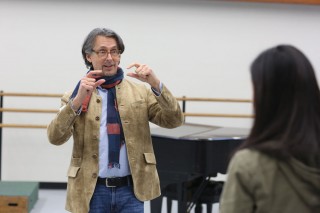Title

Faculty member Stephen Wadsworth’s three-opera cycle of Mozart-Da Ponte collaborations draws to a close with this month’s presentation of Le nozze di Figaro.
(Photo by Todd Rosenberg)Faculty member Stephen Wadsworth’s three-opera cycle of Mozart-Da Ponte productions at Juilliard draws to a close this month. All were done in a style strongly based on 18th-century wing-and-border theater and set roughly in the years they were written—revolutionary 1780s Europe. “This uniformity of approach may have given audiences a chance to savor differences or connections among the works themselves, as well as a relatively rare opportunity to look at them through the eyes of the revolutionary 1780s Europe that inspired them all,” Wadsworth told The Journal. Le nozze di Figaro opens on April 24, with Gary Thor Wedow conducting the singers and the Juilliard Orchestra. In advance of the performances, The Journal asked Wadsworth a few questions.
Body
If you could ask Da Ponte and Mozart one question each, what would it be?
For Da Ponte: “What was your decision about handling the tone of the Beaumarchais play, as you wrote this libretto? But wait, let’s go have a meal and you can tell me.” For Mozart: “Please lie down on this couch and tell me about your father while I make some notes.” I might have to tell them both that this opera and Don Giovanni helped save my life, and nothing I could ever say or do could repay the debt.
Which is your favorite character in Figaro?
Gut response: Figaro, because he taught me how to survive when I was a child, with his frank acknowledgment of life’s complexity and his resilience. He bounces back every time, and every time with hope in his heart. But Susanna is another sustaining, lifelong friend—smart, dear, and just as determined as Figaro to come through the storm, which in her case threatens her physical and emotional integrity. Both remain essential to me, and to my way of moving through the world.
A year ago, you staged the Beaumarchais Figaro plays in your own translation at McCarter Theater in Princeton, N.J. Did that experience inform or influence your concept for the opera?
I’ve spent most of my career working to understand text in its historical context, and presenting plays and operas with an ever-keener sense of how history and aesthetics merge in them. The art of the 18th century documents the emotional life of that time, which came to head in a conflict so heartbreaking, so devastating, and so exciting that the art born in these years captures and encodes cubic tons of energy and feeling, nowhere more pointedly than in Beaumarchais’ Marriage de Figaro.
Opera people insist that Mozart and Da Ponte’s version is innocent of politics and just a very merry romp that turns on love and love alone, but any work about its moment captures the zeitgeist, and a work as edgy as Figaro, play or opera, which directly challenged a faltering society to turn itself inside out, shoots the zeitgeist forward in time as from a gun. I suppose that working on the plays deepened my empathy for the characters on both sides of the class divide—for their courage at the breaking point, for their suffering at what was or was being taken from them, for their near inability to comprehend past and future privations. Mozart practically grabbed the play from the stage, and had set it and premiered it less than two years after its Paris premiere, and his kaleidoscopic music captures all of this and more. It is impossible to consider his Figaro as innocent of anything, least of all the fire of defiance that drove him. Which brings us back to his father….
Take a behind-the-scenes look at this production and hear more from Stephen Wadsworth in this video.




